


Vampire drain is the power consumed while a vehicle is parked. All modern cars, both ICE and EVs, keep some circuits powered up even when parked. This includes alarm systems, FOB detection, clocks, and more, depending on how sophisticated a vehicle is. (Jun-2025)
ICE Vehicles • EVs • Vampire Drains • Settings • Remote Control • Charging • Tests
ICE Vehicles
In an ICE car, these circuits will run down the battery. If left parked long enough, perhaps as little as 4 weeks, the owner will end up with a dead battery. There are no indicators for the owner of the amount of vampire drain in an ICE car. In addition, when the is started up after being parked, it will require more gas to recharge the drained 12V battery. This causes a slight lowering of the MPG until the battery is fully charged again. Most ICE owners are unaware of vampire drain, as there are no precise indicators measuring vampire drain.
EVs
In an EV, the 12V battery is charged from the main battery. The vampire drain is noticeable due to an EV’s range indicator, where you note the range when parked, and upon return, the range has gone down.
In the case of Tesla vehicles, there are several features, if active, that consume more power and will reduce the range while parked. In the best cases, you should expect about 1-5 miles of range loss per 24 hours when parked. With some nice features, this can go up to 22-32 miles of loss per day. With climate forced on in very cold or hot conditions, power consumption can easily consume 20 miles of range per hour! These features, often not available on ICE cars, are cool, but you may not need or want them if it reduces the needed range while parked. Some features have options to automatically turn off at select locations. For example, when you are parked at home or at work.
Vampire Drains
Actions and features that may cause very high vampire drain:
- Special Climate modes – Keep, Dog, or Camp
- Cabin overheat protection feature activation
- Preconditioning when not connected to external power
- Leaving a door slightly ajar, which keeps the climate on
- Turning on Climate remotely via the Tesla phone app
User-controlled features that can cause moderate vampire drain:
- Sentry mode
- Summon standby (FSD-equipped vehicles only, although tests we did showed no additional drain when on)
- Checking the car frequently via the Tesla phone app (which wakes the car for 10 minutes)
- Third-party polling apps you bought that frequently wake up the car (Teslafi, Tessie, Tezlab, etc.)
Receiving or sending data increases vampire drain if none of the other features and events are occurring. If you have a slow WiFi connection or weak cellular connection, these activities will take longer and cause an additional drain. These are automatic and are mostly outside your control.
- Downloading map updates (these are very large, but usually only once a year)
- Downloading a software update (usually 1-2 times per month, usually 1-2 GB)
- Upload of FSD data (you can opt out, and not that significant)
- Saving settings to Tesla’s server (likely trivial)
- Battery heating in colder weather conditions
Problems and Failures
- A 12V Battery nearing the end of its life will require frequent charging from the HV battery
- A coolant pump failure in some temperature conditions may cause it to run longer than desired while parked
- The door open detector failure keeps the car on all the time
Other Situations
- Some users report that installing the MCU2 retrofit increased their vampire drain. We didn’t notice that in a 2016 refreshed Model S, but perhaps older models are affected by the retrofit.
- A very weak and intermittent WiFI connection can cause the vehicle to continuously try and connect, keeping the CPU always powered up.
Settings
Special Climate Modes
To minimize vampire drain related to climate controls, in the climate screen, confirm that Keep, Dog, and Camp choices are off (i.e., not blue).
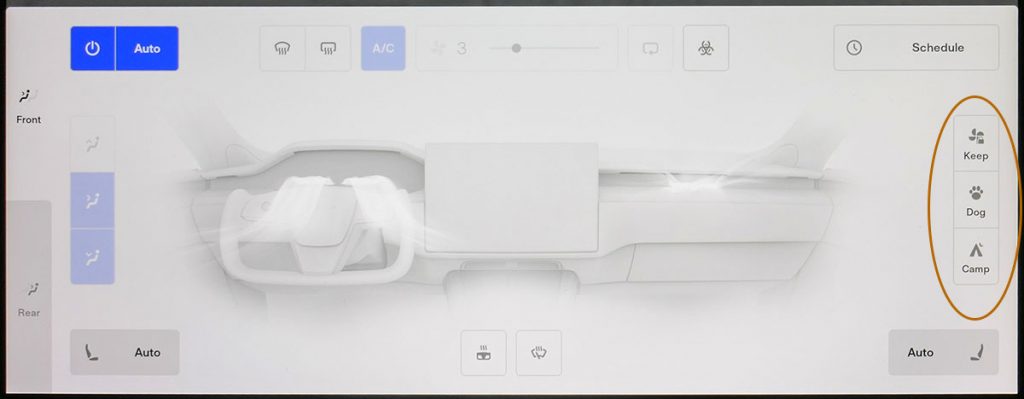
Cabin Overheat Protection
In Controls -> Safety, turn off Cabin Overheat Protection. Note, you may need to scroll down to get to this setting. Cabin overheat protection will not use any extra power if the cabin temperature remains below 105°F while parked.
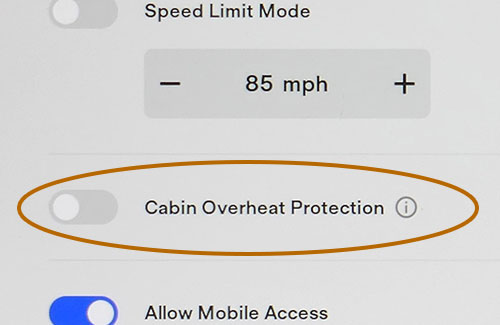
Preconditioning
Preconditioning warms the battery and turns on the HVAC based on a schedule. This feature may use considerable battery power if not connected to external power and the vehicle is cold or hot. At Controls -> Charging, use Scheduled Charge, on or off, to disable Scheduled Departure. Shown below Scheduled Charge is set on so the Scheduled Departure feature is off (yes, it is a bit confusing).
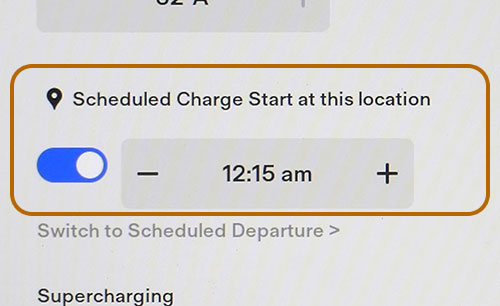
Sentry Mode
Sentry mode must keep the processors powered to monitor outside activity and record dashcam video while parked. You can turn this feature entirely off or selectively off in some locations. Access Sentry Mode from Controls -> Safety.
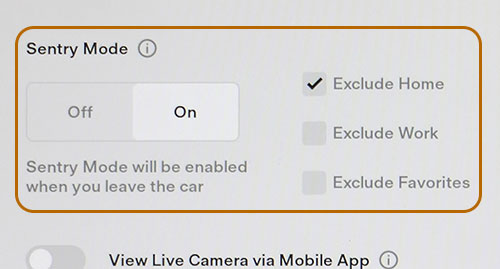
Summon
For vehicles with FSD, in Controls -> Autopilot, turn off Summon or, if on, turn off Standby Mode.
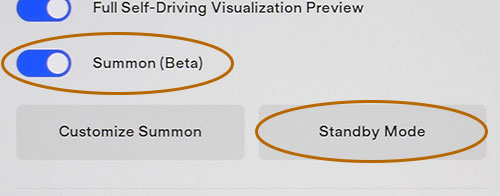
If Summon is on (as shown above), turn Summon Standby Mode off or exclude Standby Mode in some locations.
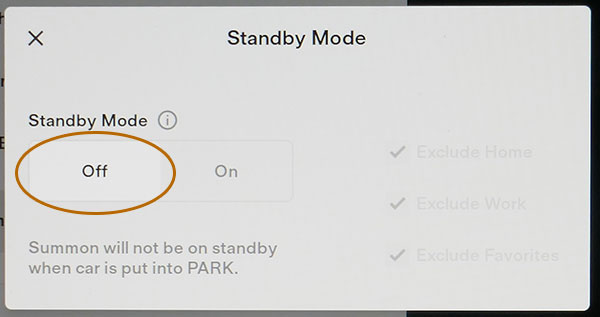
Remote Control
If you have parked your car for an extended period, perhaps at the airport during a trip, you can control a few vampire-draining choices remotely using the Tesla phone app.
- Use Climate to turn off Climate
- Use Security -> Sentry Mode to disable Sentry Mode
- Use Schedule -> Charge to disable Departure Schedule (it doesn’t matter if Scheduled charging is on or off)
Avoid using the Tesla app often, as each time you use the app, the vehicle’s processors are powered up. While not a huge drain, you lose a small amount of range each time you use the app and connect to the car. In our testing, even a short several seconds of access keeps the car powered up for 10 to 11 minutes afterwards, costing about 1/6 mile of range.
Charging & SOC
If you have the vehicle charging, the vampire drain may not be noticed. Generally, once the vehicle is charged to the level you set, the vehicle powers down, and normal vampire drain occurs. If you do not have a scheduled charging set, once the main battery’s state-of-charge drops by 1-2% from vampire drains, charging will resume automatically.
If the vehicle is below 20% SOC (State of Charge), most features above that cause Vampire drain are automatically turned off to preserve battery power.
At low SOC levels, battery temperature has a large effect on the range. For example, if you are at 30 miles of range at the end of a drive, and you stop. As the battery cools, you may lose most of the remaining range. The battery has less capacity at lower temperatures (below 80°-90F). At higher states of charge, the battery can warm itself if cool, so it has a much smaller effect.
Tests
We performed several tests to validate vampire losses and bust a few myths. To do some tests, we connected voltmeters to various points. The voltmeters are viewable outside the car to confirm when the car is powered up or down. For some tests, we video-recorded the voltmeters to get accurate timing. Tests were run in March and April 2022.
Generic Tests (should apply to all Tesla Vehicles)
Accessing a vehicle with the Tesla phone app turns on the car, and in two tests, the vehicle stays on for 10 minutes and 31 seconds, and 10 minutes and 50 seconds.
Placing a FOB key 2 feet from the front of the car, the car only remained on for 1 minute. So, leaving a key close to the car will not drain the car.
Summon Standby, for FSD-equipped cars, is supposed to add vampire drain. In our tests with a 2022 Model S LR, and all other options off, it shows the same vampire drain as with the Summon Standby off. We ran several tests to confirm. It may still be an issue on older cars and/or it is an improvement with the 2022.8.x software we were using.
Specific Vehicle Tests
Tests were conducted when all known vampire-type options were off and started 1 hour or more after the car was exited. At least 25 hours were used in each test. The count of multiple “wakeups” to check the range, less the last one, was deducted from the loss (i.e., each wakeup via the app causes the car to be on for 10 minutes). SOC (State of Charge) was at 70% or higher for these tests. Ambient temperatures were above 50°F.
The range indicator, being an integer, is not entirely precise, as the indicated range at the start and end could be +/- 0.5 miles or a total possible error of +/- 1 mile.
| Vehicle | Year | Software | CPU | Loss - All off | Loss - Sentry on |
|---|---|---|---|---|---|
| Model S LR | 2022 | 2022.8.2 | MCU-Z | 2.6 Miles/Day | 32.3 Miles/Day |
| Model S Plaid | 2021 | 2022.8.2 | MCU-Z | 2.9 Miles/Day | untested |
| Model 3 Performance | 2018 | 2021.44.30.21 | MCU-2 | 1.6 Miles/Day | untested |
| Model Y LR | 2022 | 2022.3.102 | MCU-Z | 1.2 Miles/Day | untested |